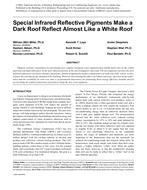Click here to purchase
Heating, ventilating, and air-conditioning (HVAC) systems account for a significant portion of energy consump- tion in buildings. The majority of fault detection research has neglected zone-level faults. In this study, the methodology of a quantitative model-based fault detection and diagnostics (FDD) system for the zone level is presented. A basic thermal model for a private office was developed to compare expected and measured office performance. Analyses were conducted and five zone-level inefficiencies were identified. The severity of these inefficiencies was analyzed, and it was found that an excessive amount of air-handling unit (AHU) fan energy consumption resulted. The redundancy of these faults in the building forces the AHU to expend an unwarranted amount of energy, highlighting the importance of using FDD at the zone level. Benefits of this methodology include the detection of preexisting faults originating from initial design as well as the ability to apply it to new or existing buildings when sufficient sensing and metering infrastructure is available, improving the efficiency of the building.
Citation: 2018 Annual Conference, Houston, TX, Technical Papers
Product Details
- Published:
- 2018
- Number of Pages:
- 20
- Units of Measure:
- Dual
- File Size:
- 1 file , 6.3 MB
- Product Code(s):
- D-HO-18-015


